
Red Aussies result from being homozygous for the red allele, and they can vary considerably in tone and shade of color. As with red merles, the body color of a red solid can vary from fairly light to so dark that the dog must be examined in the bright sun to see that it is a red and not a black. The tone can be a warm sienna or a cool burnt umber. Probably modifying genes determine the exact shade the red will be. Reds are caused by the recessive gene at the B locus, (bb). There are thought to be up to 3 different mutations of b, but it's hard to visually distinguish.

Bayshore's Cappuccino "Rio" is a handsome red tricolor puppy who is in a transition coat. The lighter shades of red are being molted as the richer red grows in to replace it. Rio's tan points are a dark cool shade of red, compared to his fiery red body. The color contrast is especially noticeable on his hock. His probable genotype is (atat bb kk mm sisi).
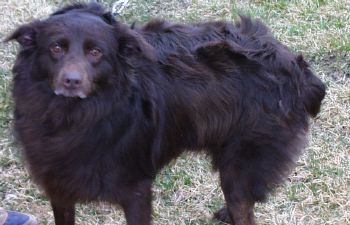
Rosie is a rescue girl. She is a fine example of a red that is so dark she could be mistaken for black at a casual glance. Her liver nose gives her away, though. She is nearly a self red, but her photographer says that her feet are white. She has very dark tan points that are nearly as dark as her body color. This makes Rosie a very minimal red tricolor. Her probable genotype is
(atat bb kk mm sisi).

This is Mistretta's Chaca, a very very dark red tri puppy with recessive blue eyes. Some reds can be so dark that they look black except in strong light. Notice her hind feet - she has smutty tan points (smudges of body color on them). In this case the smudges are red instead of black. To determine a dark dog's true color, look at them out in direct sunlight and check the color of the nose leather.
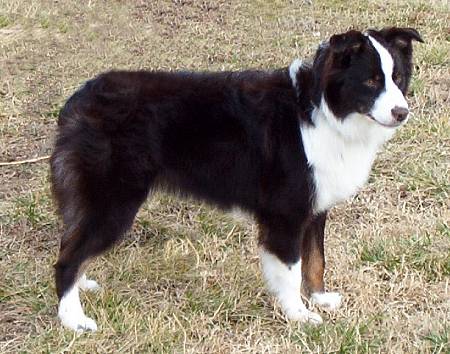

This handsome dark red tri is Overlands Rojo Mojo (Mojo), photos courtesy of Sandra Shepherd. He is so dark that even in bright sunshine he looks black. His nose is an exceptionally dark shade of liver, but it is possible to discern its color outside in bright light. In indoor light or outside on an overcast day he could easily be mistaken for black. Probably the darkness of his red is due to genetic modifiers, and this color is found in certain old working bloodlines. This dark type of red tends not to fade in the sun as readily as lighter shades, and some do not fade at all.
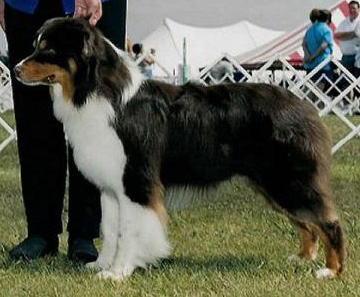
This is ASCA CH Perennial Ironman of Los Suenos, ASCA & AKC CD (Mac), photo courtesy of Alissa Behn. He is another example of a very very dark red that looks black even in this outdoor photo. Given that some black dogs have a rusty off tinge, the slight reddish highlights in his coat are not diagnostic. Again, it is necessary to look at the color of his skin - nose and eye rims. They are dark brown, identifying him as dark red rather than a reddish black. His tan points are much lighter and show up crisply against his dark coat.

This very athletic looking dog is a true self red. He has no tan points and no white. His probable genotype is (atat bb DD K- mm S-). The gene K suppresses tan points if they are present and thus creates a self colored dog. Dominant K does not allow genes at the A locus to be expressed. He may also be solid at the S locus since he s hows no sign of white markings.

This is a self red Aussie puppy, courtesy of Anita. She has no tan points and no white. Her probable genotype would be like the dog above (atat bb DD K- mm S-). Self colors like this tend to be more common in the working bloodlines where there has not been active selective breeding for white markings or tan points. Her shade resembles milk chocolate. For these shades sometimes the word chocolate is used descriptively.

This is Fairoaks Ruach of Tourmaline Hills "Ruach". He is a very deep shade of red, the color of dark chocolate. He is the result of breeding a red merle with dark chocolate patches to a lighter more typical shade of red. The exact mode of inheritance of the different shade modifiers is not known. Geneticists do hypothesize that there are 3 forms of the red gene, each perhaps yielding a slightly different shade.
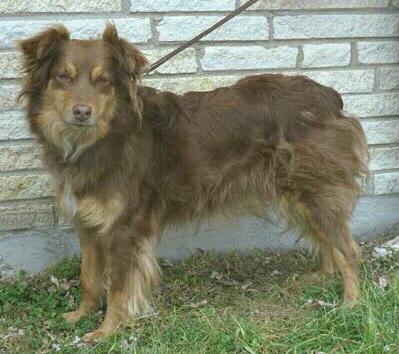
Java CGC TDI, belonging to Dave & Chris Adams, is a red and tan. He doesn't show the Irish spotting pattern. He is a cooler shade of red and has fairly crisply placed tan points. His probable genotype is (atat bb DD kk mm S-). He is similar in genetic makeup to the two self reds except that he doesn't have dominant K suppressing his tan points.
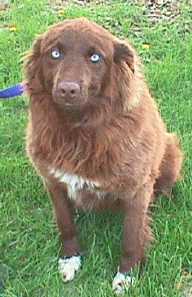
Nash is handsome red bi boy who has areas of lighter hair due to sun bleaching (photo courtesy Jayne McQuillen). Once this coat sheds he will be a uniform shade of dark red. Nash is not a merle, yet he has bright baby blues! In the Aussie breed there is a recessive gene that produces blue eyes, independent of the merle gene. Recessive blue eyes can be entirely blue like Nash's, or they can be geometrically split down the middle. They are rarely marbled as they are when acted on by the merle gene alone. Of course, a merle puppy in Nash's litter could have entirely blue eyes like his, and you could not tell by looking at them whether they were blue because of the recessive gene or blue because the merle effect acted on them. It would take a test breeding to a solid who carried the recessive blue eyes to find that out.
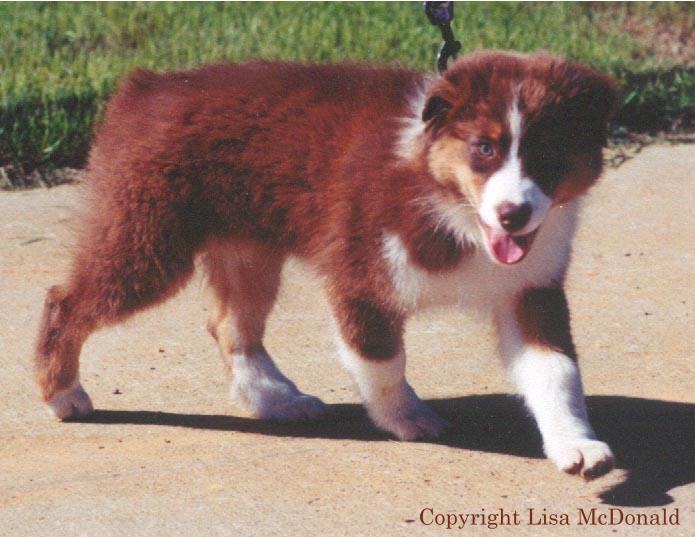
This flame red tricolor puppy is from the Kinetic kennel. His color matches his bold attitude as he strides right over to check out my camera. His Irish spotting pattern is nearly complete. His tan points are distinctly lighter than his body color. His eyes are in transition from grayish blue to amber. His probable genotype is (atat bb DD kk mm sisi).
© 1999-2009 Lisa McDonald Comments